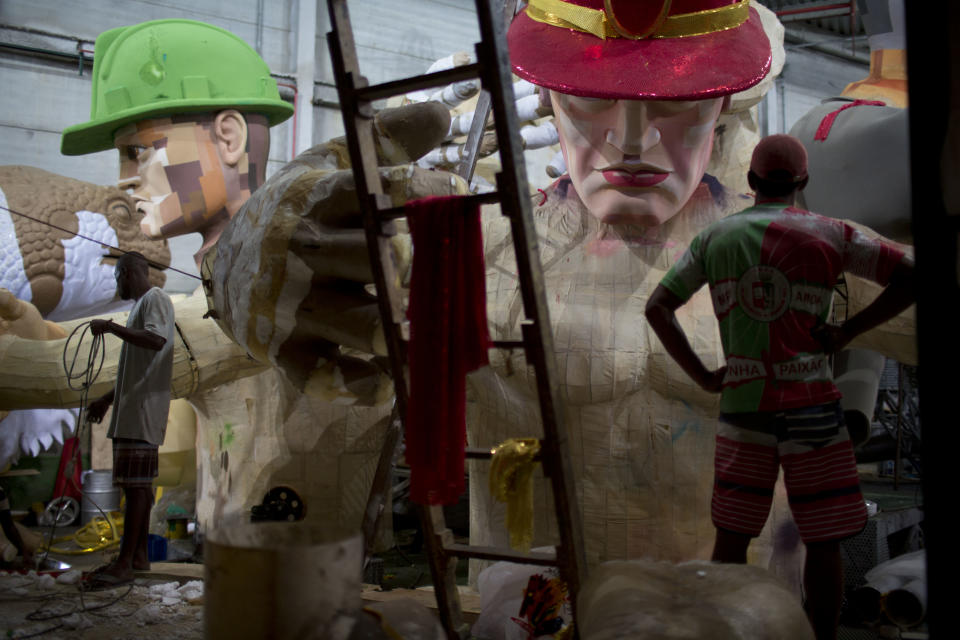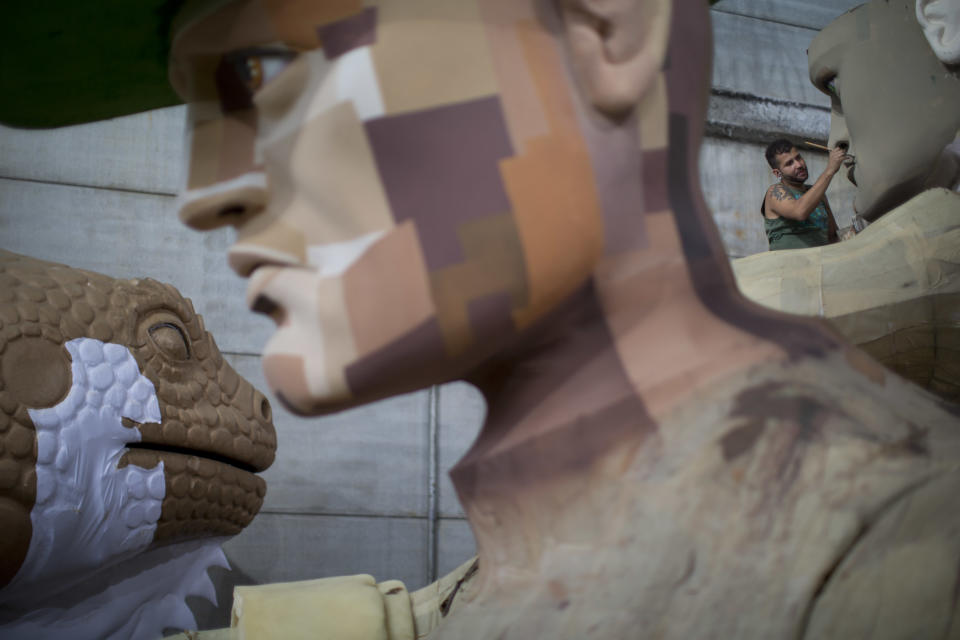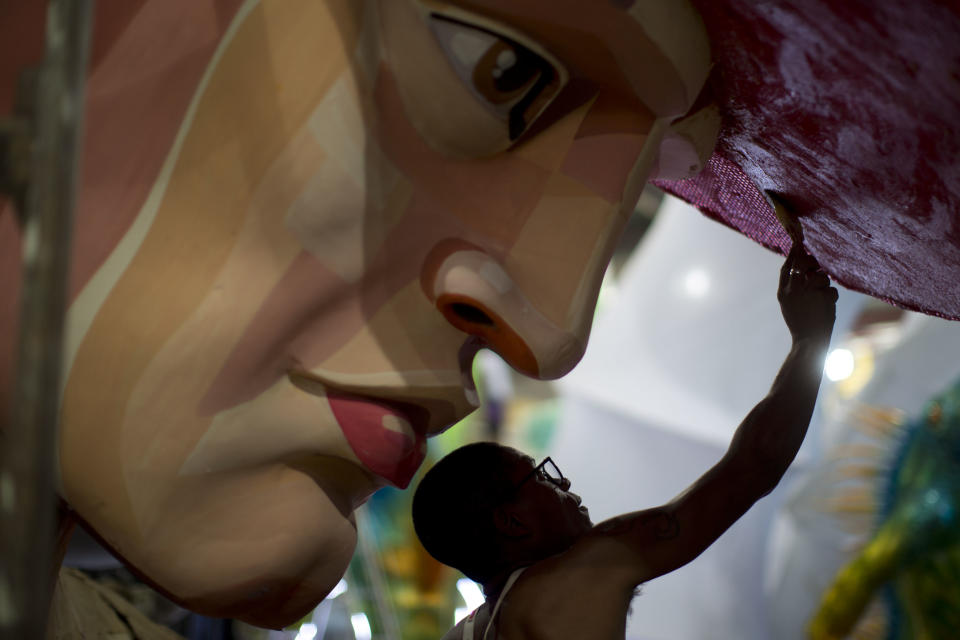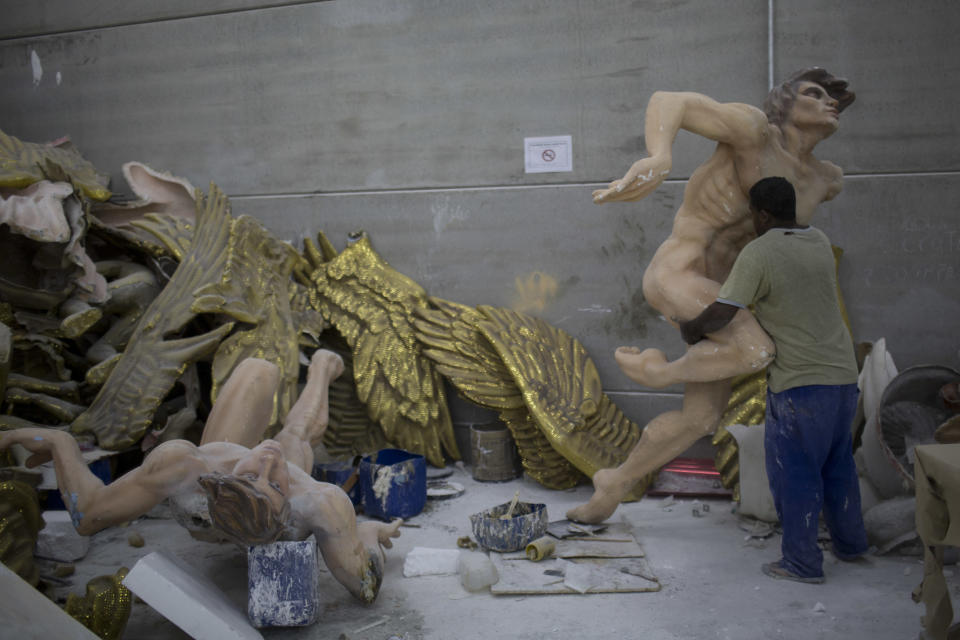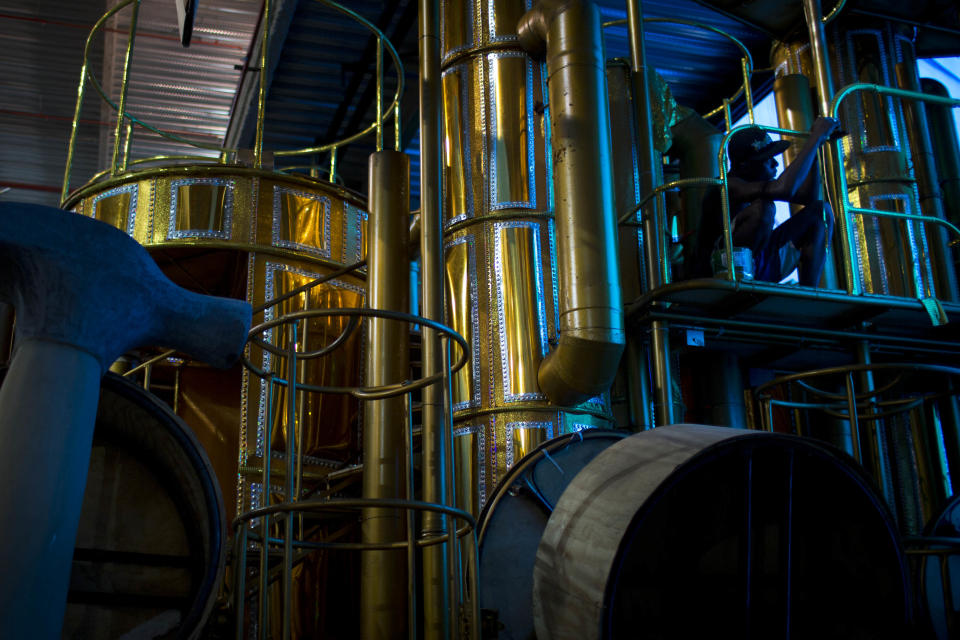Hundreds toil for months for Rio's Carnival parade
RIO DE JANEIRO (AP) — There's nothing glamorous about the industrial warehouse reverberating with the zap of soldering metal, the clatter of hammers and an earsplitting whine of a circular saw, or in the sweat-drenched workers toiling in the midafternoon summer heat among huge bolts of cloth and heavy-duty sewing machines.
Yet it's from warehouses like this one that Rio's over-the-top glitz-and-glam Carnival parades emerge, as they will Monday night for the final round of a two-day performance. The internationally renowned competition between 12 elite samba groups dazzles more than a billion spectators in person and on TV for two days, but it takes nearly a year and hundreds of workers, many of them volunteers, to pull each one together.
"We're anonymous artists. The public has no idea who builds all this," said Angelica da Silva Bernardes, one of those working in the warehouse run by the Grande Rio group. She's a telemarketer who cuts her day job to part-time during the pre-Carnival season to help out her group in the afternoons and evenings. "Our motivation is seeing the way people light up when they see our work."
Bernardes is part of an army of dedicated workers who spend their days, and, as Carnival approaches, their nights, designing, welding, carving, cutting, sewing and embroidering, all to create a seamless spectacle for others.
It's hard work. Grandmothers strain their eyes sewing for hours. Paint-stained young men in old shorts and flip-flops take naps on ratty pieces of foam laid out between work tables in the wood shops after pushing through the night. In the days leading up to the parade, the intensity revs up, and there are fewer breaks.
Directing the madness at Grande Rio's warehouse is Roberto Szaniecki, the "carnavalesco," or artistic director, who works in an all-white office on a floor above the work space, surrounded by large computer screens, slick new laptops and a team of architects, graphic designers, clothing designers, theater set producers and other technical help.
It is from Szaniecki's mind that spring the magnificent creatures being brought to life by workers in the warehouse below.
Dressed simply in a dark blue polo shirt and gray cargo pants, he sat for an interview at his white desk marked by multiple coffee-cup rings, his nicotine-stained fingers raising yet another cigarette for the deep drags that punctuate his conversation. Tacked on the wall above his head, poster-size renditions displayed the dozens of glitzy costumes that encompass the group's theme for this year's competition at the Sambadrome, where the schedule called for Grande Rio to take the floor at 12:25 a.m. Tuesday.
"We work with the collective unconscious," he said. "Each image alludes to other, shared images, so that the spectator doesn't stop to think. It's all just absorbed together with the information in the song, translating into an idea, an impression in the mind of the people watching."
In spite of the dreamlike aspect of the procession, the creative process is very planned and meticulous, Szaniecki said. The materials, colors, even the equipment used, are all specified in instructions.
Carnival means a lot to Cariocas, as Rio's residents are known. It must be taken seriously, he said.
"It's our culture, our rhythm, our aesthetic language," he said. "It's the greatest show on Earth, and it's a source of pride for the country. It's a message we send about who we are."
Grande Rio chose a controversial theme this year: the benefits that cash derived from offshore oil drilling bring to Rio. The revenues, disputed by other inland states, must be invested in the safety infrastructure and health clinics that are essential for Rio residents, the group's song argues.
The Portela group, which has won the most honors at the Sambadrome over the years, chose this year to honor Madureira, the north side neighborhood where it was born nearly a century ago. The group reached back in history to the days when sugar was king and vast plantations covered the state.
Jorge Gomes, a construction worker in the offseason, worked through lunch on a recent day affixing gold lame to a Portela float representing a sugar cane farm, complete with a fancy 19th century carriage, luxuriant green stalks rising 15 feet (4.5 meters) in the air, and majestic busts of the black men and women who were enslaved to work the fields.
"This is my passion," he said, adding that it is a love shared with his wife, son and nephew, all of them hard at work on the Portela floats that had an hour and 20 minutes to shine in the Sambadrome starting at 2:25 a.m. Monday. "I'll leave any job I'm doing when Carnival approaches."
Many of those dedicated to the roller-coaster of Carnival preparations describe it as Gomes did: an irresistible addiction. The tension of not knowing if it will all come together in time, followed by the great blowout that is the parade, makes them feel alive in a way nothing else does.
Those who love this can't stop themselves from returning, year after year, in spite of the exhaustion, the cost and the time eaten up in the process, said Claudio Schneider, a hairdresser who stops working every August to dedicate himself exclusively to being an "aderecista" responsible for the decorations that top the floats. He doesn't return to hair until after February.
"I can't stay away," Schneider said. "I go to bed at 5 a.m., get up three hours later and keep working. There is no money that pays for that kind of dedication."
He also was taking part in the parade this year, one of the plumed figures in the group's procession.
Gomes' life also revolves around Portela. "This takes all the best I have to give: time, money, family, dedication," he said,
He has been building floats since he was 13, and has developed a technique for carving in plastic foam. Over the years, however, he's learned to do any job needed, he said as he explained with pride of ownership the step-by-step of putting a float together.
First, a metal structure is fabricated to provide the "bones" of the float, he said. Then come the basic wooden blocks, which need to be sturdy enough to hold dozens of costumed samba-dancing participants for hours. Then the elaborate decorations — fiberglass or plastic foam sculptures, which must be draped in cloth, painted or embroidered.
Unlike Schneider, Gomes seldom joins in the parade, preferring to watch from the stands so he doesn't miss any of the show. He confessed that he cries when he sees his work debut on the parade ground.
"Each year, it's a child of mine that is born before the public eye," he said. "The emotion is too big for words."
